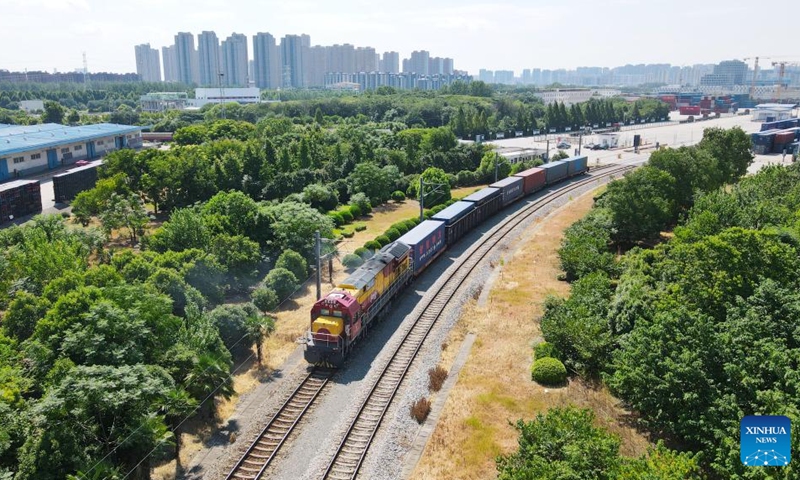
This aerial drone photo taken on Aug. 1, 2024 shows a China-Europe freight train departing from the logistics base of Hefei north railway station in Hefei, east China's Anhui Province. A total of 380 China-Europe freight trains departing from Hefei between January and July this year, marking a 3 percent increase from the previous year. Photo: Xinhua
The China-Europe freight train, a pillar of cross-continental transport, has maintained a robust growth, with trips from January to July increasing 12 percent year-on-year, according to China Railway on Sunday. This growth has injected new impetus into stabilizing the East-West supply chain.
The continuous upgrade and standardization of cross-border train services, including increased competitiveness compared with sea transport and the implementation of a full-time schedule, have been crucial for business growth, traders and the railway service operator said.
From January to July, a total of 11,403 trains were dispatched, up 12 percent year-on-year. The trains delivered 1.22 million TEU (20-foot equivalent unit) containers, a year-on-year increase of 11 percent, data released by China Railway showed on Sunday.
In July alone, 1,776 China-Europe freight trains were dispatched, and for a third consecutive month, more than 1,700 trains were operated.
Tommy Tan, president of Shanghai EPU Supply Chain Management Co, is a direct witness of how the train service upgrade changed his business this year.
"Our business via the China-Europe freight train has grown by about five percent so far this year," Tan told the Global Times on Sunday, expressing an optimistic outlook for this year's train service.
Tan's company has been using the trains to serve multiple European cities, including Lyon in France and Budapest in Hungary.
The growth of the China-Europe freight train is mainly driven by service upgrades, such as a full-time schedule. This makes train transport more competitive than sea routes, which face longer detours due to the ongoing Red Sea crisis, industry insiders said.
Unlike the previous model under which local railway departments set separate running times, a full-time schedule means the arrival and departure times as well as the routes are fixed in each section.
Since the implementation of the third full timetable for the China-Europe freight train services in mid-June, the scale of operations has been expanding. Currently, 17 trains are running weekly, connecting major trade hubs such as Southwest China's Chengdu and South China's Guangzhou to Duisburg in Germany, and Łódź in Poland, with reliable transportation efficiency ensured by operating on a passenger train-like schedule, according to China Railway.
The operating efficiency of the train has improved year-on-year, cutting the cost, Gao Hongjin, president of Ulanqab Foreign Economic and Trade Cooperation Investment Development Co, told the Global Times on Sunday.
The service continues to expand. On Friday, a train carrying 110 standard containers of home appliances departed from Qisumu in Ulanqab in North China's Inner Mongolia Autonomous Region and crossed into Mongolia through Erenhot, heading to Nizhnekamsk, Russia, according to Jining Customs. This launch of this trip highlights the growing regional connectivity.
The China-Europe freight train from Erenhot is now operating at full capacity, Gao said, indicating good potential for growth. He predicted that the cargo train business will get even better.
